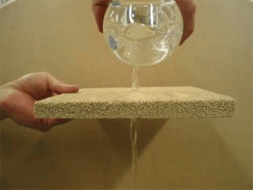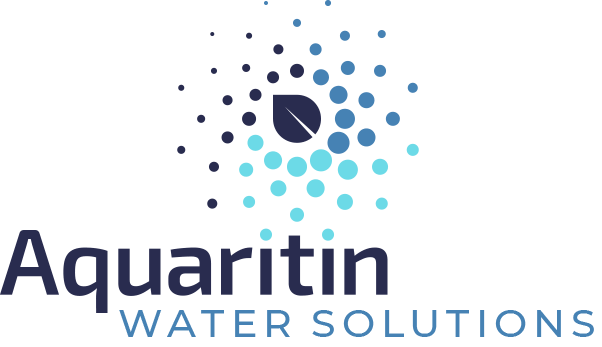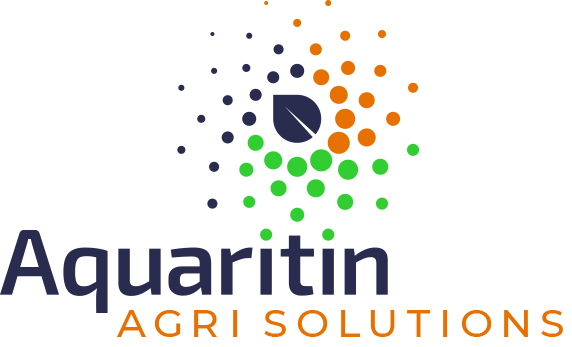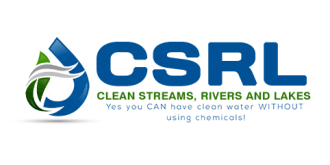
Calcium Silicate ( Wollastonite ):
• Natural and Organically Certified (OMRI)
• Controls Filamentous and Planktonic Algae growth
• Will not harm fish or other aquatic vegetation
• Safe to use in irrigation ponds and outdoor garden water features
Phosphorous bonds with Calcium Silicate removing excessive pond nutrients by making them unavailable, so the Algae are unable to proliferate . By correcting the source of the problem, the pond's aerobic bacteria will breakdown organic wastes and restore a balanced pond ecosystem.
Calcium Silicate removes excess phosphorus through mineral sequestration, by forming Calcium Phosphate, a stable and inert mineral. With its food source eliminated, the Algae dies off.
* Suggested Rates: 25 Lbs. {11.3 Kgs) per Acre Foot.
Because of the uniqueness of every lake or pond , rates will vary, so additional treatments or other treatment ingredients i.e. Diatom promoter, Beneficial Bacteria and aeration whenever possible, may be also used.
Treating Algae chemically or by mechanically removing it from the lake or pond are short term solutions that can lead to oxygen depletion and fish kill. The goal is to reduce/remove excess nutrients (aka pollution) and maintain cleaner water bodies.
By adding Calcium Silicate to water bodies we have found that all of our other treatments, including Diatom promotion and Beneficial Bacteria are amplified and work substantially better with less treatment cost.
Have Clean Streams, Rivers and Lakes include this sand like mineral as part of your lake or pond treatment.
Read Scientific Articles over last 20 years that backup the success of this mineral:
- The Evaluation Of Specialized Permeable Like Calcium Silicate Media for Phosphorous Removal
- Phosphorous Runoff Risk Assessment and Its Potential
- Phosphate sorption capacities of different substrates in view of application in water treatment systems for ponds
Our Water Treatment Programs use Calcium Silicate, Aquaritin diatom promoter and Beneficial Bacteria and, when possible, Aeration to clean streams, rivers, ponds and lakes. Get a free quote from us today!
Here is some research we base our water treatment programs on:
Interactions between Diatoms and Bacteria
Potential of diatom consortium developed by nutrient enrichment for biodiesel production and simultaneous nutrient removal from waste water (NuAlgi aka Aquaritin)
Use of Bacillus species in maintenance of water quality
Impact of organic carbon acquisition on growth and functional biomolecule production in diatoms
Call Matt 571-436-6327 for free consultation.

BIO - Remediation - Beneficial Bacteria with and without incorporating High Tech Ceramics (Bio-Generators). See our Specials Page for bio-generator products that eliminate the need to constantly add bacteria to water.
Works great with complete solutions. Controlling Harmful Algae Blooms. Harmful Algae Blooms (HAB) such as Cyanobacteria (blue-green algae) represents a nuisance in water where excess nutrients and growing conditions exist. HAB’s can excrete hazardous toxins and produce toxins that create drinking water problems, limit use of beaches, create fish kills and odors that affect residents and visitors. The result places economic burdens on communities. This is a serious problem nationally and over 60 percent of freshwater bodies are impaired, affecting some 80,000 miles of rivers and streams and 2.5 million acres of lakes, reservoirs, and ponds, and coastal seawater.
Long term, key nutrients need to be lowered, such as phosphorus (P) and nitrates (N) using Best Management Practices. In the interim, Pro-Biotic water quality treatments can minimize the effects of HAB. It is known that HABs can be controlled using bacillus bacteria.
Beneficial Bacteria
Use Bio Reactor/Generators where water enters ponds and lakes. (streams and rivers}.
Run off drainage, chemicals, fish, birds, fecal matter, dead plants, decaying fish or bugs, leaves, grass and twigs all contribute to excessive nutrients that lead to poor water conditions. These "fuels" allow problems to rapidly multiply - leading to an unhealthy and undesirable lake or pond ecosystem overburdened with odors, sludge and undigested decay. Yearly organic deposits build-up and charge the bottom sludge layers resulting in rich nutrient beds leading to unsightly conditions, odor and reduced clarity. This bottom settling sludge layer is rich in nutrients and provides an endless food supply for algae, weeds, cloudiness, algae blooms, odor, slime, phosphorus, nitrates, ammonia and more. Since many chemical based treatments require constant re-treatment, water tables often become toxic over time, which is highly unsafe for people, pets, fish, soil beds and the environment.
Beneficial Bacteria produce enzymes that allow them to break down organic and chemical compounds and take them into their cells as nutrients. Many bacteria also perform de-nitrification, transforming nitrate into nitrogen gas and removing it from the pond system. They can also convert soluble phosphorus from the water column into calcium phosphate and calcium iron phosphate, making those nutrients unavailable to weeds and algae. Our Class 1 safe beneficial bacteria blends aggressively digest and break down sludge, scum and decaying organic matter into harmless water and carbon dioxide while reducing muck. Our beneficial bacteria blends also support promoting growth of healthy good diatoms.
Beneficial Bacteria treatment requires multiple treatments that are not practical for larger water bodies. For larger water bodies, streams and rivers we deploy MetaMateria’s Bio-Lair and Bio-Reactor products to treat the water with safe Class 1 bacillus type strains of beneficial bacteria designed specifically are especially effective in reducing nutrients needed to support HAB. PO4 Sponge removes more reactive phosphorus than other products and Bio-Lair sustains high bacteria levels that break down existing algae blooms and keep them from reforming.
Bio-Lair is a porous ceramic product with exceptionally high amounts of surface for bacteria reproduction. It has 100 times more surface than plastic products. This allows large populations of bacteria to develop that are 5 times higher than normal and these will out-compete algae for nutrients. Blooms break down and do not reform.
Bioremediation is widely used in nature and in waste treatment systems to remove organics, N, and even biologically tie up soluble P. A key to using Bio-Lair for HAB control is selecting the right combination of beneficial bacteria with high bacterial count for a quick start-up.
Bacteria are known to help control algae blooms and break down organics in bottom sediments. High concentrations of enzymatic bacillus and pseudomonas bacteria are effective in breaking down existing blooms. Bacillus bacteria naturally form in soils and there are thousands of strains. While useful in controlling HAB, bacteria suppliers require repeated treatments throughout the algae growing season, sometimes as often as every 2 weeks. While this may be feasible for smaller ponds; it is costly and repeated treatment is impractical for larger water bodies. New bacteria have to be added regularly because the surfaces for colonization are largely on the bottom sediment, not up in the water where it is needed for HAB control. Bacillus bacteria will reduce sediment thickness (sometimes by 12 inches/year).
Bio-Lair is packaged in nets or other custom configurations and can be located up in the water where it becomes an ideal substrate for reproduction of beneficial bacteria needed to maintain higher concentrations up in the water. This reduces a need for regular bacteria additions. HAB breaks down and does not reform, as long as the nutrients remain controlled.
Bio-Lair sustains high concentrations of the beneficial bacteria that have been used effectively with commercial bacteria blends that cost less than comparable products on the market. High concentrations of colonizable bacteria that begin working quickly. To better understand the power provided by this combination of the right bacteria blend and Bio-Lair. It is helpful to examine how these unique products work together. While many bacteria products exist, there are significant differences between the type and quantity of active colonizable bacteria available. Bacteria are one of the oldest life forms on earth and are present in virtually every environment. In fact, the number of beneficial bacteria far outweighs the number of harmful strains, such as the HAB cyanobacteria.
Bacteria are absolutely essential to the natural recycling of nutrients throughout the environment and they biologically maintain healthy water by breaking down nitrogen, carbon, and other contaminants and can even biologically incorporate some soluble P. This is nature’s way of controlling contaminants, and for a normal environment, existing bacteria are enough to do the job; however, when excess contaminants exist, such as proteins, oils or unhealthy bacteria, or when oxygen is too low, water quality suffers and supplemental bacteria can provide the extra help needed, especially when blends of bacteria can handle a broad array of contaminants, allowing water to be cleaned faster.
BIO-Lair represents a Pro Biotic bacteria factory that constantly creates new bacteria on the enormous surface available. A fog of bacteria is swept into surrounding water and the high concentrations needed to control HAB can be maintained.
Depending upon the conditions, the bacteria lower nutrients in the water and breaks down organics to keep the water clear. Amazing results occur when BIO-Lair is used with the right blend of beneficial bacteria. Once treated, algae disappear in weeks and never reform. New bacteria may be needed but this media can last five or more years!
Similar results in controlling algae are found in treatment of fish and shrimp ponds where nutrient levels are particularly high. Bio-Lair used with bacillus bacteria was able to control algae blooms in aquaculture ponds with no repeat additions of bacteria needed. HAB in other water bodies. Economics of treatment depend upon the specific application but are much less than chemicals.
Bio-Lair is a trademark and product of MetaMateria, Inc. Clean Streams, Rivers, and Lakes is a distributor for these in custom configurations designed for your specific application.
Use Bio Lair Generators where water enters ponds and lakes. (streams and rivers}.
Run off drainage, chemicals, fish, birds, fecal matter, dead plants, decaying fish or bugs, leaves, grass and twigs all contribute to excessive nutrients that lead to poor water conditions. These "fuels" allow problems to rapidly multiply - leading to an unhealthy and undesirable lake or pond ecosystem overburdened with odors, sludge and undigested decay. Yearly organic deposits build-up and charge the bottom sludge layers resulting in rich nutrient beds leading to unsightly conditions, odor and reduced clarity. This bottom settling sludge layer is rich in nutrients and provides an endless food supply for algae, weeds, cloudiness, algae blooms, odor, slime, phosphorus, nitrates, ammonia and more. Since many chemical based treatments require constant re-treatment, water tables often become toxic over time, which is highly unsafe for people, pets, fish, soil beds and the environment.
Beneficial Bacteria produce enzymes that allow them to break down organic and chemical compounds and take them into their cells as nutrients. Many bacteria also perform de-nitrification, transforming nitrate into nitrogen gas and removing it from the pond system. They can also convert soluble phosphorus from the water column into calcium phosphate and calcium iron phosphate, making those nutrients unavailable to weeds and algae. Our Class 1 safe beneficial bacteria blends aggressively digest and break down sludge, scum and decaying organic matter into harmless water and carbon dioxide while reducing muck. Our beneficial bacteria blends also support promoting growth of healthy good diatoms.

We are a distributor for Aquaritin Water Solution Products.
Automated/Manual Addition of Aquaritin - Creating Diatom Blooms.
Aquaritin is a patented water treatment solution made of nano-scale micronutrients (5-100nm) required for multiplication of the ubiquitous and beneficial diatoms in any water body. Aquaritin is all natural and contains Si, Fe, Mn, Ca, Mg, Zn, Cu, B, S, Mo, P, K and Co.
Through the introduction of copious diatom blooms, this revolutionary nano-scale formula significantly increases the amount of dissolved oxygen while kick starting the natural biological cycle already occurring in waterways.
Diatoms are living single-celled organisms. In your pond, stream, river and lake they consume Phosphorous and Nitrogen/Nitrates as well as other chemicals, thus depriving weed and hazardous algae from having it. The patented solution that we use to promote or rapidly grow diatoms contains micronutrients so as to only promote a bloom of high level or good diatoms.
Diatoms are the only organisms on the planet with cell walls composed of transparent silica.
Diatoms have light-absorbing molecules (chlorophylls a and c) that collect energy from the sun and turn it into energy through photosynthesis. Through carbon fixation, diatoms remove carbon dioxide (CO2) from the atmosphere. The CO2 is converted to organic carbon in the form of sugar, and oxygen (O2) is released. We breathe the oxygen that diatoms release. 20% to 30% of the air we breathe is created by diatoms in fresh and ocean waters.
Diatoms produce long-chain fatty acids. Diatoms are an important source of these energy rich molecules that are food for the entire food web, from zooplankton to aquatic insects to fish to whales.
Diatoms are particular about the quality of water in which they live. If they don’t divide and multiply they die in about six days and become diatomaceous earth at the bottom. The goal is to get the chemistry of the water back to where they thrive on their own.
Diatoms are vital for assessment and monitoring the condition of waters. Our diatom promoter’s patented natural formulation is designed only to produce good high level diatoms.
(Source: https://diatoms.org/)
How Does Aquaritin Work To Balance Biological Filtration?
Aquaritin causes a controlled and sustainable growth of beneficial diatoms.
Diatoms are special types of micro-organisms that live inside 'glass houses' - they have hard outer shells made of silicon and oxygen, the same elements that make up glass. These outer casings are made of two half cylinders that fit together like a jewelry box. Inside this shell is a single celled organism that photosynthesizes, releasing oxygen.
The oxygen is used by aerobic bacteria to break down organic matter.
Higher DO levels result in tangible changes like cleaner water, reduction in BOD, lower coliform levels, elimination of foul odor, reduction in mosquito colonies in water and healthier aquatic life. Aquaritin is a substitute for algae control and nutrient reduction products.
Silica is a valuable part of the Aquaritin Bio Filter Process
How does CPRL Automate Adding Aquaritin to drainage, streams, rivers and lakes?
CPRL has designed systems identical to agricultural dosing systems where we can meter and time the dosing of the proper amount of Aquaritin to match the flow rates for drainage, streams, rivers and lakes. Higher end models include remote communications, cell, phone and text feedback.
Why Encourage Diatom Algae Growth?
Diatoms are responsible for almost one fourth of the oxygen produced on Earth.
Due to their glass like structure, they need less light to photosynthesize and therefore photosynthesize faster and earlier in the day, out-competing filamentous algae like harmful Blue Green Algae (BGA) or green algae for nutrients such as N and P.
Highly mobile, Zooplankton feed on the diatoms and the fish feed on zooplankton thus completing the natural food chain in a healthy water body. The organics exit the water in the form of fish biomass as the biological filter is improved.
What Are The Specific Changes That Aquaritin Causes In Water?
1 liter of Aquaritin releases 200 to 1000 kgs of Oxygen, Produces 200 to 1000 kgs of Diatoms, Consumes 16 to 80 kgs of N and 2 to 12 kgs of P, Consumes 300 to 1400 kgs of Co2 and thus will significantly increase the amount of dissolved oxygen in the water while balancing the biological aquatics.
What can Aquaritin inexpensively treat?
Lakes, Rivers, Streams, Ponds, Run-Off Drainage, Storm Drainage, Water Treatment Facilities; basically anywhere you need cleaner water.
Are There Any Toxicity, Precautions and Side Effects?
Aquaritin has been tested to be non-toxic as per APHA (2012) and OECD (1992).
Aquaritin has no impact on humans and is even safe if small amounts are consumed accidentally. Beneficial bacteria, zooplankton and fish grow in a healthy manner in lakes and water bodies dosed with Aquaritin. Overdosing will cause excess diatoms and water will turn brown from too much Diatoms, a simple decrease in dose or skipping a dose or two will correct over dosing.
Society normally wishes to maintain a reasonable level of productivity in its lakes, rivers, and estuaries and this requires the presence of modest levels of nutrients. Historically, many water bodies have progressed from low productivity or oligotrophic settings to productive mesotrophic conditions to over enriched eutrophic or hypertrophic conditions. The results are often algal or cyanobacteria mats, anoxia, and fish kill leading to greatly reduced biodiversity.
The accumulation of nutrients in a water body causes ecological imbalances and results in ‘Eutrophication’. Nutrient input causes growth of algae and weeds. If the algae and weeds are not consumed by Zooplankton and Fish, they die and decompose and the nutrients remain in the waterway.
Phycoremediation is defined as the use of brown Diatom algae to remove pollutants or nutrients from the environment or to render them harmless. Diatoms can fix carbon-dioxide by photosynthesis and remove excess nutrients efficiently at minimal cost. In addition oxygen produced photo synthetically with diatoms can relieve BOD in the water. The use of micro algae for the treatment of municipal wastewater has been subject of research and development for several decades.
Oligotrophic lakes are dominated by Diatoms and Eutrophic lakes by Cyanobacteria. In eutrophic lakes, diatoms may dominate in winter and spring and blooms of cyanobacteria occur only in summer through autumn.
In winter and spring the water quality is generally good but deteriorates in summer and autumn due to the algal blooms. The seasonal succession of phytoplankton is depicted very well on the website Water For The World (http://waterfortheworld.net/)
Using diatoms to control water quality is a unique idea for effective, eco-friendly and cost effective lake, river, stream and pond management. Aquaritin has been in use for many years in Australia and around the world to manage water in Lakes. Use of Aquaritin does not need any special equipment, construction and skilled manpower. It harnesses the enormous potential of diatoms to consume nutrients rapidly and thereby control other nuisance algae like BGA and water weeds.
Sewage, fertilizer, etc., contains more of nutrients and less of micro-nutrients. Diatoms are the last group of algae to have evolved about 200 million years ago and they are more complex than other algae and growing good safe diatoms require more micro-nutrients.
Thus diatoms cannot grow once the micro-nutrients in the water are exhausted. This typically occurs by summer and is the main reason for Cyano blooms in summer and autumn. Adding micro-nutrients into waterways to enable diatoms to grow even in summer and autumn is a safe and proven phyco-remediation solution.
CLICK HERE TO SEE OUR AQUARITIN AGRICULTURAL PRODUCT LINE


Aeration( bottom up bubblers )
important ALL YEAR LONG:
Winter: allow water to stay exposed to release dangerous pond/lake gases out;
Spring: Limits spring fish kills, weed and algae growth starts;
Summer: Boosts water column mixing, improves water quality and provides oxygen during hottest months;
Fall: reduces fish kills by seasonal turnovers, keeps pond columns mixed and healthy.
***************************************
Aeration in general
We use aeration whenever possible to accelerate our water treatment programs. Aeration brings water and air in close contact in order to remove dissolved gases (such as carbon dioxide) and oxidizes dissolved metals such as iron, hydrogen sulfide, and volatile organic chemicals (VOCs). Aeration is often the first major process at a treatment plant. An Aeration system is used in ponds and lakes and what is essential is to increase the dissolved oxygen content of the water throughout the lake and pond. This aeration can be done several ways: by injecting pure oxygen, mechanically agitating or mixing the water, or injecting air. An aeration system is usually in the form of a fountain that is in the middle of the lake or pond. If there is a pond or lake that does not have an aeration system, it can greatly benefit from having one. Here are some of the benefits to having an aeration system a lake or pond. There are also cool new pumps that produce nano bubbles that work on the chemistry of the water by attaching to particles in the water.
Benefits of Aeration
Aeration is not the cure-all for the problems a lake and pond can face. It can be misused, and when it is, it will not help, but hinder the problems. It is important to have a professional analyze and help where needed. When aeration is used properly, it can help and improve the water and habitat.
Increase Aquatic Habitat
Benefits of aeration in ponds and lakes. When there is aeration, the plant and animal life will thrive because of the oxygen that will be constantly flowing through the water. This will also help prevent fish kills. When the plants at the bottom of the lake are getting a good amount of oxygen, they will grow healthier and the fish that eat the plants will have a good amount of food that is growing.
This will be even more beneficial for warm water fish. They tend to struggle in an oxygen-deprived habitat because they require an adequate amount of dissolved oxygen levels. An aeration system will help the oxygen levels of the lake to further better the habitat of the warm water fish.
De-stratification
Stratification can be created and be problematic for the natural resources and environmental managers. Stratification is when the lake is separated into layers of different temperatures. Having an aeration system will circulate the water so there are no more separated layers that have different temperatures. Common techniques for destratification are air injection and mechanical mixing.
Water Quality
When there is oxygen deprived water, the plant life at the bottom will release different gases and metals that create water quality problems. When there is an aeration system, the water quality will greatly improve because oxygen will circulate throughout the whole lake, including the bottom sediments. The water quality will be enhanced by stabilizing the pH, removing carbon dioxide, and alkalinity. The more problems a lake has the more treatment will be needed. An aeration system like a fountain will decrease the amount of treatments that are needed to help the problems in a lake or pond. Clean Streams, Rivers and Lakes personnel are experts at deciding if this would be a good part of a solution for your pond or lake and suggest the proper equipment to use and where.
Fountains
Fountains aerate the top layer of your water and add aesthetic touch to your pond or lake. We have several brands and types with and without lights that you can use on your pond or lake including solar powered.
*******************************************
NEW - Nanobubble Technology
Lakes & Pond Remediation (Algae control) using reasonable capital expense to acquire and operate.
Maintaining adequate dissolved oxygen (DO) levels in water is a critical component to sustaining healthy ecosystems in lakes and ponds. Low DO levels and the presence of nutrients such as nitrogen and phosphorus can lead to algae blooms in the epilimnion that further deplete DO concentrations and degrade water quality. Sustaining DO levels across the entire water column, including the hypolimnion, helps mitigate algae growth by reducing the rate of nutrient recycling into the water from the sediment layer. However, effectively aerating the entire water column with conventional aeration systems poses difficulties, as oxygen transfer is poor in warm and shallow water bodies, while distribution of oxygen to the hypolimnion layer is challenging in deep water applications. Harnessing the power of nanobubbles, Nanobubble generators have proven that it can cost-effectively reduce and prevent harmful and unsightly algae blooms by effectively aerating the entire water column independent of depth or temperature.
Chemical Free Treatment
Nanobubble generator's gas-injection technology produces billions of nanobubbles per milliliter of water, each less than 200 nanometers. This enables Nanobubble generator's generators to transfer oxygen with greater the 90% efficiency. This efficient oxygen transfer utilizing compressed air helps ponds rapidly increase dissolved oxygen throughout the entire body of water allowing beneficial bacteria to thrive and consume nutrients before algae blooms occur. Customers who have installed Nanobubble generators report elimination and prevention of algae without the use of a single herbicide, pesticide or other chemical-based algae treatment.
DO Mixing and Distribution
Due to the nanobubbles' neutral buoyancy, they are able to evenly oxygenate the entire water column, thereby achieving the same DO level at all depths of a pond. This is particularly important because the presence of oxygen at lower depths prevents the hypolimnion, the dense bottom layer of water, from becoming anoxic. Sufficient oxygen at the bottom layer of the water column prevents the release of nutrients from the sediment, helping mitigate algae blooms. Additionally, the nanobubbles are able to oxygenate the sediment passively, minimizing agitation and improving turbidity and water clarity.
Non-invasive Plug & Play Solution
Nanobubble generators are positioned outside the body of water. Customers can typically install and commission a nanobubble system in half a day by simply connecting PVC or flexible hoses to and from the generator to the body of water and connecting the generator to a power source. These simple to install, energy efficient systems, help aquatic management companies and their customers eliminate and prevent algae more cost effectively than the use of traditional, invasive aeration systems or fountains combined with chemistry.
Price yours out today!
Call Matt 571-436-6327
